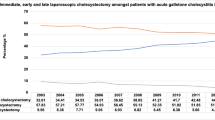Abstract
Background
Postoperative cholangitis is a common complication of pancreaticoduodenectomy. Frequent cholangitis impairs patients’ quality of life after pancreaticoduodenectomy. However, the risk factors for recurrence of cholangitis remain unclear. Hence, this retrospective study aimed to identify risk factors for recurrence of cholangitis after pancreaticoduodenectomy.
Methods
The medical records of patients who underwent pancreaticoduodenectomy between 2015 and 2019 in our institution were retrospectively reviewed. At least two episodes of cholangitis a year after pancreaticoduodenectomy were defined as ‘recurrence of cholangitis’ in the present study. Univariate and multivariate analyses were performed.
Results
The recurrence of cholangitis occurred in 40 of 207 patients (19.3%). Multivariate analysis revealed that internal stent (external, RR: 2.16, P = 0.026; none, RR: 4.76, P = 0.011), firm pancreas (RR: 2.61, P = 0.021), constipation (RR: 3.49, P = 0.008), and postoperative total bilirubin>1.7 mg/dL (RR: 2.94, P = 0.006) were risk factors of recurrence of cholangitis. Among patients with internal stents (n = 54), those with remnant stents beyond 5 months had more frequent recurrence of cholangitis (≥5 months, 75%; <5 months, 30%).
Conclusions
Internal stents, firm pancreas, constipation, and postoperative high bilirubin levels are risk factors for cholangitis recurrence after pancreaticoduodenectomy. In addition, the long-term implantation of internal stents may trigger cholangitis recurrence.

Similar content being viewed by others
References
Gouma DJ, van Geenen RC, van Gulik TM et al (2000) Rates of complications and death after pancreaticoduodenectomy: risk factors and the impact of hospital volume. Ann Surg 232:786–795
Ito Y, Abe Y, Kitago M et al (2018) Predictive factors of late cholangitis in patients undergoing pancreaticoduodenectomy. World J Surg Oncol 16:19
Hiyoshi M, Wada T, Tsuchimochi Y et al (2016) Hepaticoplasty prevents cholangitis after pancreaticoduodenectomy in patients with small bile ducts. Int J Surg 35:7–12
Bassi C, Marchegiani G, Dervenis C et al (2017) The 2016 update of the International study group (ISGPS) definition and grading of postoperative pancreatic fistula: 11 years after. Surgery 161:584–591
Rahbari NN, Garden OJ, Padbury R et al (2011) Post-hepatectomy haemorrhage: a definition and grading by the International study group of liver surgery (ISGLS). HPB (Oxford) 13:528–535
Koch M, Garden OJ, Padbury R et al (2011) Bile leakage after hepatobiliary and pancreatic surgery: a definition and grading of severity by the International study group of liver surgery. Surgery 149:680–688
Kiriyama S, Kozaka K, Takada T et al (2018) Tokyo guidelines 2018: diagnostic criteria and severity grading of acute cholangitis (with videos). J Hepatobiliary Pancreat Sci 25:17–30
Fuyo Y, Hisayuki O, Yuji A et al (1996) Internal Stenting of the hepaticojejunostomy and pancreaticojejunostomy in patients undergoing pancreatoduodenectomy to promote ealier discharge discharge from hospital. Surg Today 26:665–667
Tang SJ, Armstrong L, Lara LF et al (2007) De novo stent-stone complex after long-term biliary stent placement: pathogenesis, diagnosis, and endotherapy. Gastrointest Endosc 66:193–200
Kaneko J, Kawata K, Watanabe S et al (2018) Clinical characteristics and risk factors for stent-stone complex formation following biliary plastic stent placement in patients with common bile duct stones. J Hepatobiliary Pancreat Sci 25:448–454
Hao WL, Lee YK (2004) Microflora of the gastrointestinal tract: a review. Methods Mol Biol 268:491–502
Dimidi E, Christodoulides S, Scott SM et al (2017) Mechanisms of action of probiotics and the gastrointestinal microbiota on gut motility and constipation. Adv Nutr 8:484–494
Bassotti G, Stanghellini V, Chiarioni G et al (1996) Upper gastrointestinal motor activity in patients with slow-transit constipation. Further evidence for an enteric neuropathy. Dig Dis Sci 41:1999–2005
Ueda H, Ban D, Kudo A et al (2017) Refractory long-term cholangitis after pancreaticoduodenectomy: a retrospective study. World J Surg 41:1882–1889
Yamaki S, Satoi S, Yamamoto T et al (2022) Risk factors and treatment strategy for clinical hepaticojejunostomy stenosis defined with intrahepatic bile duct dilatation after pancreaticoduodenectomy: a retrospective study. J hepatobiliary Pancreat Sci 29:1204–1213
Funding
This research did not receive any specific funding from any agencies in the public, commercial, or not-for-profit areas.
Author information
Authors and Affiliations
Corresponding author
Ethics declarations
Conflict of interest
The authors declare no conflicts of interest associated with this manuscript.
Additional information
Publisher's Note
Springer Nature remains neutral with regard to jurisdictional claims in published maps and institutional affiliations.
Supplementary Information
Below is the link to the electronic supplementary material.
Rights and permissions
Springer Nature or its licensor (e.g. a society or other partner) holds exclusive rights to this article under a publishing agreement with the author(s) or other rightsholder(s); author self-archiving of the accepted manuscript version of this article is solely governed by the terms of such publishing agreement and applicable law.
About this article
Cite this article
Fukuoka, H., Toyama, H., Mizumoto, T. et al. Risk Factors for Recurrence of Cholangitis After Pancreaticoduodenectomy and Comparison of Stents in Hepaticojejunostomy. World J Surg 47, 2499–2506 (2023). https://doi.org/10.1007/s00268-023-07104-3
Accepted:
Published:
Issue Date:
DOI: https://doi.org/10.1007/s00268-023-07104-3




